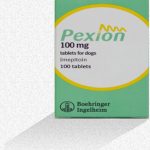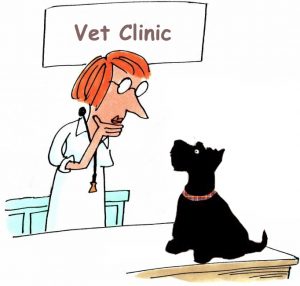Ron Hines DVM PhD
 Destructive Behavior and Separation Anxiety
Destructive Behavior and Separation Anxiety
 Is This The Right Dog For My Family?
Is This The Right Dog For My Family?
Fear and aggression are the two most exasperating behavioral problems that veterinarians deal with in dogs. Many dogs that are labeled as aggressive are actually motivated by fear and suspicion. It always saddens me to see a dog tremble and pull away to escape from a situation that should not be causing fear or terror. Dogs, like all animals, are creatures of habit. Their inclination is to be cautious about things they have no past experiences with and to avoid situations that brought them grief in the past. I believe that the pain dogs experience due to fear is as real as any of the other source of pain that veterinarians attempt to alleviate. Fears and phobias are also among the most common reasons that dogs are surrendered to animal shelters. These fears and phobias are also among the most difficult problem animal shelter staff face when attempting to find a new home for the pets in their care.
Clues That My Dog Is Fearful And Anxious In Specific Situations
In most situations, you cannot help but notice. Your dog stands with it head lower than its back. It avoids eye contact with people who are nearby. It might freeze or attempt to escape with its tail tucked between its legs. It might pee on objects or the floor. Your dog might growl and raise its lips in a warning. Its tail stops wagging and its body curves sideways or arches. It might cower and look around apprehensively for a place to hide. Frightened female dogs in particular tend to urinate. Others lose their bowel control. Escape is the first thing on their mind. If your dog runs away, it might look back over its shoulder to be sure it is not being pursued.
But in other situations, more subtle signs of fear can be easily missed or misinterpreted. Erect eared dogs might carry them flatter. Many fearful dogs tremble and shiver. Some lick their lips, others yawn when they are feeling stressed, fearful or anxious. Still other pets whine and whimper. Tensed muscles related to fear are also common. Fearful and self-destructive behaviors don’t just pop up suddenly out of nowhere. It’s just that the early signs that they are brewing are subtle, and we tend not to notice them. Your vet might notice that your dog’s body temperature is a bit above normal.
What Are Some Caused Of Canine Anxiety Problems?
Lack of early positive interactions with humans and other dogs, homeless living, a yard dog’s life, lack of normal stimulation or abuse all contribute to a dog’s deep-seated fears and anxiety. But not every dog that goes through those tribulations develops long-lasting psychological issues. Your reaction to traumatic events in your life and theirs depend in part on genetic vulnerability. (read here) To what extent unreasonable fears are due to these individual and breed genetic variations and to what extent they are environmental is something veterinarians and animal behaviorists argue about. I believe that these underlying genetic factors play a considerably larger part in your dog’s behavior than many dog therapists are willing to admit.
The critical period for canine socialization is 8-16 weeks of age. That is the period when your puppy’s acceptance of new experiences is most plastic (susceptible to change). The later in life that a dog encounters a new, potentially frightening situation, the harder it is for most dogs to accept them – particularly when the results of that first encounter are negative.
We know that it is common for a dog with one unreasonable fear (one that might have been due to past abuse) to later develop another unreasonable fear or compulsive behavior – even when living in a much better home environment. We know that shy and timid dogs tend to produce puppies that are also shy and timid. The neuter status of your dog and its age when that surgery was performed also factor in. (read here & here) There are also breeds, such as pinchers and terriers, that tend to be more alert, skittish and temperamental than other breeds. Those were considered a positive trait in a good ratter.
Positive experiences, training and therapy can all lessen those tendencies, but they are unlikely to entirely erase them. For your dog, a goal of improvement is more realistic than striving for a total cure.
Are Some Dog Breeds Likely To Have More Anxiety Issues Than Others?
Yes.
Herding dogs such as border collies, Australian shepherds and Shetland sheep dogs seem more prone to anxiety issues than many other breeds. German shepherds, Labrador retrievers, miniature schnauzers, wheaten and Staffordshire terriers are also high on the list. (read here)
Dogs had no better friend that John Paul Scott
I would like to tell you about Dr. Scott. He was to dog psychology what Sigmund Freud was to human psychology. And over time, Dr. Scott’s theories have held up considerably better than Dr. Freud’s have.
Everything I mention about critical socialization periods in my articles on aggression, neurotic behaviors, fear, and environmental enrichment, comes from Dr. Scott. John Paul Scott was a professor of psychology at Bowling Green State University in Ohio. Over time, he also became the most influential dog trainer in the world. In 1965, along with John Fuller and the support of the Jackson Laboratory, he wrote Genetics And The Social Behavior Of The Dog, a book based on his observation of dog behavior beginning in 1945. Dr. Scott selected five dog breeds, basenjis, beagles, cockers, shelties, and fox terriers – each for their distinctive breed personalities and temperaments. He put them through, what today would be called a puppy school. From the day they were born, the pups were observed every 10 minutes through a one-way mirror until they were 16 weeks old. His was the first study to observe the significant differences in how each breed behaved. When the pups were 4 weeks old, he began to isolate some of them from their mothers to see how their personality developed under various conditions. That is how he discovered how crucial that early period was for a dog in developing into an adult without fears and phobias. He found that from 3-12 wks of age, puppies bonded easily with people, with other dogs and developed a lack of fear of objects in their environment (fire hydrants, street signs, etc.). That was the same time they developed a lack of fear of novel locations. It didn’t take much – a brief positive encounter did the trick – for life. If that 3-12 week window closed without those experiences, the puppy’s ability to accept those experiences as normal and non-threatening was never easy, and sometimes it was impossible. No matter whose website you are using to learn about dog psychology, you are reading the thoughts and impressions of Dr. John Paul Scott.
In the 1990s, using the vast knowledge he had acquired, Dr. Scott took a stand against the AKC. He maintained that the skin-deep judging methods of the Organization that persist through today had resulted in breed temperaments that were erratic and undependable. He had come to believe that if you crossed two breeds and created a mutt, you were considerably more likely to create a psychologically healthy dog than if you continued to rank and breed purebred dogs in skin-deep, superficial ways. He warned that if champion breed selection criteria were not altered, there would come a time when dog owners would not be able to afford the cost of the veterinary and psychological care that their purebred dogs would require. No one at the AKC took him seriously then. No one does now. The AVMA doesn’t take him seriously either – although they should know better. And, of course, the movie industry and popular press never took him seriously. I, and a few other veterinarians take him seriously. The downside of inbreeding and mindless selection is not only psychological, it is highly detrimental to your dog’s physical health as well. (read here & here)
Dr. Scott documented that cocker spaniels and shelties were considerably less likely than his other breeds to respond negatively to sudden sounds like a doorbell ringing. He also found differences in the trainability of the five breeds. Cocker spaniels and fox terriers learned the command sit-stay faster than the basenjis, with the other breeds falling in the middle. When it came to problem-solving, no breed outperformed the others. The beagles sniffed out scents the best. The basenjis learned how to discover hidden food treats that required them to pull strings or move objects best. When two of the five breeds were crossed to each other, their pups moved up on the ability scales one parent was low at and down on the scale a parent ranked high on. Those experiments confirmed how important your dog’s genes are in determining its future personality and abilities.
Some dog owners, after reading this far about Dr. Scott, might jump to the conclusion that what their dog missed out on as a puppy they can supply now that their dog is an adult. That must be done very cautiously – particularly when aggression is a part of the problem. Dogs that are prone to fear or to attack other dogs, people or children should never be taken to shopping centers, parks, doggy parks or doggy daycare centers without a protective muzzle. Everyone, including your dog, is put in needless danger when you don’t do that.
What Are Some Of The Most Common Situations That Dogs Find Fearful And Stressful?
Noise Aversions – The Fear Of Loud Noises & Thunder
That’s my dog Maxx. Maxx is quite fearful of thunder. Fear of thunder and loud noises is probably the most common of all dog phobias. In some dogs, the noise causes only mild anxiety. You nearby, some extra coddling and praise and some hands-on comforting usually solves the problem. But in other cases, dogs becomes frantic. In those cases, the symptoms are major and can take a long time to dissipate. Your dog might run off or hide. It might refuse to come out when you call. It might dash out into traffic. What begins as only a fear of thunder can progress into fear of a variety of sudden loud noises. Noise-related fear problems tend to increase as dogs age. Your dog also senses quite accurately how thunder and lightening affect you. If thunder and lightening cause you to expressed or just feel anxious, your dog will sense that, and it will likely become anxious as well.
Although the methods I mention later often help lessen the fear of loud noises, the best solution is always to avoid placing your dog in situations where the pet is forced to deal with them. When that is unavoidable, or you just need a safe fall-back option, consider the purchase of a thunder shirt. If that is unsuccessful, ask your veterinarian to issue your dog an antianxiety medication. Some find clorazepate, alprazolam or acepromazine satisfactory. A new medication option is dexmedetomidine (SILEO®). There is great variation as to what the effects of any of these medications will be on your dog. Neither you nor your veterinarian can know until you give each a try. I generally begin dogs on a third to a half of the suggested dose until I observe what its effects are. Effects are extremely variable. With time and additional non-drug approached, a point often arrives when none of these drugs are required. When administering drugs that affect the mind, it is always wise to both begin and to end their use gradually.
Fear of Fireworks
Dogs that are disturbed by thunder are often also frightened by the sounds of fireworks, gunshots, loud cars etc. Any sudden unexpected loud noise and flash of light can cause those dogs to tremble, drool, run or hide. Some dog owners have attempted to desensitize their dogs to those sounds by playing recordings of these sounds at the same time they give their dogs treats. They start with the volume low and gradually increase the volume in subsequent attempts. Perhaps that is sometimes effective; I have never tried it. Any pleasant diversions you can think of for your dog while the fireworks displays are in progress are likely to be calming. The same medications I mentioned for fear of thunder should be appropriate for these situations too. There have been studies that suggest that perhaps chronic pain can also make dogs more sensitive to noise. (read here) So be sure your vet checks your dog for pain-causing issues as well.
Fear Of Separation – I Don’t Want To Be Alone!
I wrote a separate article on separation anxiety in dogs. You can read it here. It is a very common problem. My dog Maxx is blessed with that issue too. Since dogs were created as pack animals, the thought of being alone can terrify them. So, anxiety on separation is really not abnormal. You know you’ll be back – but how does your dog know? It is only when anxiety is present in the extreme that destructive events tend to occur. I believe that many medical conditions that dogs suffer from – things like periodic diarrhea, hair loss, weight loss, weight gain, intestinal obstructions, loss of house training, excessive grooming, eating stones, socks and the like, and even scratching can all have elements of separation anxiety as an underlying cause. I mentioned that phobias often increase as dog age. So, some of those events can be mistakenly written off as simple age-related dementia. (read here) Panting, vocalizing, shaking and pacing sometimes are all that occur; but just as frequently dogs dispense with those preliminaries and go on to their physical compulsions with little or no outward signs of anxiety. I have extracted many socks from dogs, only to have the dogs swallow the socks again when their owners left for work in the days that followed.
Obedience training is of little help. Success lies in how you plan your departures and returns. Read more about that through the links I gave you. The signs of boredom and of separation anxiety overlap. But boredom is a much easier problem to deal with. When in doubt, try adding more mental stimulation to your dog’s daily life. Puzzle feeders when you are away, toys, leaving a TV or radio on and the like. This exaggerated fear of abandonment, when present, is deep in your dog’s soul. It might take the guidance of a trained dog behaviorist to improve the situation. I rarely suggest continuously medicating your dog long-term. However, medications can be helpful, temporarily, while a program of desensitization to your absence is in progress.
Fear of Car Rides
As Dr. Scott discovered, the early experiences of puppies condition them as to what is pleasurable and what is not. An automobile can be quite intimidating to a dog that had no prior experience inside one. Cars can be a noisy, smelly, and confining behemoth to a dog that first encounters one in adolescence or later in life. Dogs are born quite adaptable. But their acceptance level is greatest in puppyhood. If they learned general trust and acceptability as a puppy, they will retain more of that plasticity into adulthood. Shelter dogs often lacked that critical early exposure. Those dogs are likely to remain wary of the unfamiliar. Other dogs haven’t forgotten car rides ending in unpleasant experiences in their past – like trips to their veterinarian, their initial encounter with animal control or a car accident. In one Italian questionnaire study of 1,031 dog owners, about 24% of their pets had some anxiety issues with car rides. The number doubled when a trip to their veterinarian was their only destination. (read here)
With time and effort, most dog owners are able to assist their dogs in overcoming those fears and to enjoy car rides. The key is patience, small steps and lots of positive reinforcement as you and your dog progress down that path. Smaller dogs are often much less apprehensive in their personal pet carriers – ones they already accept as a refuge or lounging bin in your home. Perhaps throw their blanket and some of your soiled clothes in the rear seat as well.
Frequently, one member of the family will have more success than another in reassuring a dog to enter a vehicle. A team of two or three persons the dog is familiar and comfortable with might overcome reluctance better than a single individual tugging or pushing. The more upset you become, the less likely your dog is to cooperate. Dogie car seats and comfortable restraints are fine if they don’t compound your dog’s fears and discomfort. If they do upset your dog, just drive responsibly or slowly back and forth in your driveway without them for a while. For fearful dogs, nothing like this please – just a pet carrier (a “crate”) already familiar to your dog. Dogs that are unfamiliar with crates at home are not going to like being placed in them in cars. Treats and praise will slowly lure most dogs into a car when the vehicle’s motor is off – particularly when your dog is quite hungry. Empty stomachs also decrease the likelihood of car sickness. If not, just time spend in happy activities near your car is a step forward. Often, having several car doors open lessens a dog’s fear of getting inside a vehicle. If your dog suffers from carsickness, ask your veterinarian for recommendations on an OTC motion sickness medications such as dimenhydrinate (Dramamine®, etc.) or meclizine (Bonine®, etc.) in a weight-appropriate dose for your dog. Delay feeding your dog until after its return trip home. Be sure your pet has an opportunity to void its bowls and bladder before car school begins.
Dragging your dog to your car, hollering, struggling or becoming upset are all counterproductive. That just reinforces your dog’s suspicions that cars are something to be avoided. Have patience. It can take many weeks to overcome this problem with small steps forward and an occasional step backwards (relapses). When you finally do take a car ride together, make the destination a park or other place you know that you and your dog will enjoy, never a veterinary clinic or grooming salon or crowded mall. Here is another thing I harp about frequently: be sure your dog has your identification on its collar (with the offer of a generous $$ reward) so that it can be returned to you should it become lost (as fearful dogs are prone to do). Dogs with separation anxiety issues are often fence diggers and escapers while you’re away.
Fear of Animal Hospital Visits
Two thirds of the dogs taken for a ride to their veterinarian’s office would prefer to be going somewhere else. Strange smells, strange dogs, unfamiliar people and a hoist onto a cold slippery examination table, not to mention the upcoming shots, are nothing they look forward to. In one German study, almost 80% of dogs were unhappy on examination tables. Fewer than half of the dogs entered the animal hospitals willingly and 13.3% had to be dragged or carried in. (read here)
Dogs have a truly amazing sense of smell. They possess about 300 million odor receptors in their nose compared to about 6 million in yours. The hospital’s previous canine patients left behind their messages of anxiety and stress in their anal gland and pheromone secretions. Dog can detects those messages from a considerable distance (over a mile). Is there any wonder that your dog arrives at the Caring Hands Animal Hospital or Lap Of Love Clinic suspicious? The animal hospital may look and smell immaculate to you. Staff may be smiling, music may be playing, but no amount of Febreze™, Pine-sol™ or Clorox™ will erase those left-behind canine messages. Your dog still reads them loud and clear. Your dog’s experience on exiting its appointment might confirmed its earlier suspicions.
Dogs are also highly sensitive to the fears and emotions of you, their owner. They read you like a book. If you are stressed, nervous, fearful or apprehensive, if you have had a bad day, they are certain to know it and key their emotions off of yours. If at all possible, do not schedule optional veterinary appointments when you yourself are under pressure. If your blood pressure goes up when you visit your doctor (the white coat syndrome), you yourself might be part of your dog’s “hospitalitis” problem. Sensing your nervousness, the visit might also increase your dog’s blood pressure readings. (read here) Mild lamenesses and other problems that you noticed at home and that were the reason for the visit might not occur when you want your vet to observe them. Perhaps another family member or friend might have better success when veterinary visit time comes around. There are medications you might take. But ask your physician about that. Oftentimes, veterinary hospital staff will pick up on you and your dog’s anxiety before you do. So, when they smile and suggest that your dog “be taken to the back”, don’t assume they will do something horrible back there. Your pet may be considerably more tolerant and comfortable with its exam and shots without your presence than with it.
Are There Things I Can Do To Lessen My Dog’s Fear Of Hospital Visits?
Yes
Once your puppy’s initial series of vaccinations are complete, enroll your dog in a socialization class. Until then, socialize your dog with the sociable dogs of your friends and family.
Pretend to be a veterinarian at home. With an “assistant” present, open your dog’s mouth and examine its teeth, tongue and throat. Check in its ears. Squeeze (palpate) its abdomen. Lift and examine its legs and feet. Check under its tail. Put your dog on a moderately elevated table and reassure it that it will not fall off. With time, a higher one. All the while, stroke and encourage your dog and give him/her favorite treats. Don’t do any of this if your dog is inclined to bite.
If you already know that your dog would not tolerate your doing any of that, your dog has larger issues than fear of veterinary hospitals or veterinarians. Seek out an experienced dog trainer. Oral and injected calming medications are no substitute for the help and advice that those professionals can offer.
Visit your veterinarian with your dog socially – not for a health examination. Bring some tasty dog treats. Bring your dog when it is quite hungry. Have the staff pet, massage and fuss over your dog with encouragement as they give your dog the treats. Call ahead to schedule the time. No need to bother the vet, the support staff and location is what needs to have a positive place in your dog’s mind. Ask for a time slot when the clinic is not packed and the staff is less stressed. If they are unwilling to do that or plan to charge you, go elsewhere.
If you or your dog get nervous in the waiting room, ask the receptionist if there might be a side room or unoccupied exam room where the two of you could wait. Alternatively, take your leashed dog for an outside walk in the area or wait with your pet in your vehicle and ask the receptionist to inform you when the veterinarian is ready to see you. Bring no children. They are a distraction to your dog, to the staff and to you.
Use the skills that your dog already knows by asking the pet to lie down, stay, etc. and by feeding it treats every few minutes or so while you wait for the appointment. Always have your dog on a short leash, not one that uncoils with the press of a button. Slightly taut leashes give dogs a sense of security and remind them that you will be making the decisions.
For routine procedures, you might search for a veterinarian who makes house calls. Many more veterinarians do that now than they once did. They also tend to be an empathetic subset of individuals with excellent interpersonal and dog-intuitive skills. If it is just the hospital setting that frightens your dog, not the examination itself, you might find a veterinary house visit to be the easiest solution to your dog’s anxiety problem. Sometimes, personalities are not compatible. If the first veterinarian and your dog don’t click, try another vet.
The Dreaded Nail Trim
Few dogs get enough exercise on hard surfaces to naturally keep their nails at a proper length. Dogs often fear nail trims more than any other procedure. It can be a real struggle for the dog and those like me that attempt it. (see here) That fear can spill over to include veterinary hospital visits for any reason. The quick of a dog’s nails are exquisitely sensitive. Further compounding the situation is that it is practically impossible to visualize the sensitive nail root in dogs with black toenails. It only takes one accidental clip into the quick of the nail to give dogs a lifelong fear of having their nails cut. For dogs that will tolerate the whine of an electric nail grinder, I suggest you trim your dog’s nails at home a little at a time at frequent intervals rather than bringing the pet to an animal hospital. If you are not up to that, discuss the situation with a trusted groomer. You don’t go to your doctor for a manicure and there is really no reason for most dogs to go to their veterinarian to have their nails trimmed – short of your pet requiring injected sedation to perform the procedure.
Fear of Going Up and Down Stairs
The first thing to do when you have a dog that hesitates to climb stairs is to take it to your veterinarian to be sure the problem is not related to joint, leg or spinal pain. Poor vision can also be responsible for hesitancy. When you are certain that it is not some physical infirmity causing your dog to put on the brakes as it approaches stair steps, consider if it is a dog that never encountered stairs as a puppy. Perhaps a shelter dog or one that lived exclusively in a run or one-story ranch home.
Your dog’s favorite tasty treats, placed on a stair step just above his reach when your pet is hungry, are the best cure. Start with entrance steps – no more than a few steps high. Do not attempt to drag your dog up the stairs or shove the pet from behind. Someone can go up the stairs above both of you and offer words of encouragement. Praise the dog with happy talk with every advancement. Be patient, when your pet tires of the game, call it quits for the day and begin again tomorrow. Any progress – even a no progress days – are worthy of praise. If the problem is beyond these simple suggestions, seek the counseling of a dog trainer or canine behavioral specialist.
Fear of Strangers And Children
Some dogs are fearful of all strangers. Others are only fearful of specific strangers such as mailmen, men in general, children, women in specific clothes, etc. These are generally very submissive dogs. They are the kind that pee when fearful or anxious. Those dogs, when approached by strangers, tend to crouch, cower or lay down on their back or side when approached. Their body is often curved, their tail between their legs and their ears held low. They tremble, their muscles are tense, and they tend to glance or dart for a hiding place where they feel safer. If they are forced into a confrontation with a feared person, they are apt to growl or snap. Some associate this issue with prior abuse. That might be partially true, but a dog’s genetic makeup is probably to blame as well. Terriers and toy breeds suffer this type of fear considerably more frequently than the larger working breeds. Terriers, toy breeds and lapdogs in general are not breeds specifically developed to be outgoing. They were bred to be highly sensitive and dependent on their owners. Those disposition traits are magnified when they were not exposed to multiple individuals when they were puppies. The problem is best dealt with through positive reinforcement, which I ‘ll tell you about shortly.
Fear of children requires extra caution. Just as with fear of strangers, this phobia is usually due to a lack of exposure to children when the dog was a puppy. Dog owners struggle with this problem most frequently when their dog became their pet before children were introduced into the family. The reverse is considerably less common. Psychologically healthy dogs and puppies that are brought into a family with children almost always adapt well on their own to the children’s presence. You cannot just assume that your new grown or partially grown dog will love your children immediately. It might take time and effort before that occurs. Dogs with fear tendencies easily misinterpret the intents of rowdy or noisy children. If one child pulls its tail, yanks it fur, abuses it in other ways or accidentally steps on it, your dog might mistakenly assume that all children will. A problem with positive conditioning to fix these situations is that while most adults are capable of reading a dog’s intents, children often are not. So incorporating them into positive conditioning lessons can be dangerous to the child if you are not vigilant. Some dog owners are competent referees in a positive reinforcement program between dogs and children, but quite a few people are not. Because of that, I suggest you employ a professional dog trainer when faced with a dog’s fear of children.
If there is even the remotest possibility that someone including you will be bitten or injured, your dog needs to be muzzled during any form of behavior modification. If your dog has personality idiosyncrasies that are a danger to other people and dogs, avoid those situations and when forced into them, provide your dog with a protective muzzle.
How Can I Help My Dog Deal With Fear And Phobias?
Positive Reinforcement
Positive reinforcement is the technique of rewarding your dog for good behavior while not rewarding it for bad behavior. Notice I did not say punish it for bad behavior. The two best rewards for dogs that I have found are tasty treats and praise. Some include walks, car rides, clickers and the like as rewards. But I have found that immediate gratification seems to work better. If it’s just you and your dog, only the two of you need to play. But if yours is a larger family, involve everyone mature enough to take part – with just one person at a time interacting and you in the distant background observing.
Here is one simple scenario:
Say you come home only to find that your dog pooped in the house. You are frustrated, perhaps angry. You think your dog let you down. Dogs have a phenomenal ability to read their owner’s emotions. Your dog knows you are upset. It cowers and looks sad because you look sad. You misinterpret that as shame for having pooped in the house. You speak to your dog in a sharp tone or yell. Your dog gets even more upset. You think your dog will never do such a thing again. The next day, you come home and the dog has pooped in the house. That is because your dog never had the slightest understanding why you were upset yesterday. It did not understand your lecture at all. Perhaps it is now starting to become anxious about the consequences of your coming home. You don’t want to reinforce that. Much as we would like them to be, dogs are not furry little people. They understand our body language considerably better than our words.
Here is what you needed to do:
The next day you come home earlier. Or you don’t feed the dog until you come home much earlier. Or, you crate the dog for the afternoon you are away. When you come home you watch your dog until it begins sniffing around and walking in circles. You immediately put its leash on and take it outside. When it poops where you want it to poop, you praise it effusively, pat it on the head and give it a few treats. You play with it. The next day and the next, you do the same thing. When it has potty accidents – as it likely will – you clean them up and ignore them. With time, those accidents should stop. If they don’t your dog might have medical issue such as IBD, garbage raiding, compulsive object swallowing, intestinal parasites and the like.
The same principle of rewarding good behavior and ignoring bad behavior is the cornerstone of all canine behavior modification. It works hand in hand with puppy and dog training in which dogs learn to perform tasks that you desire. Like walking calmly on a leash, patiently waiting, coming when called, laying down, rolling over. With every new ability, your dog’s bond with you grows stronger and its ability to learn new behaviors and let go of bad ones increases.
Conditioning Your Dog Through Repetition
Your dog is unlikely to learn a new response to a situation on its first, second or third try. Desensitization to fear and behavioral modification take many repetitions and a lot of time. It helps when you can recreate the stage set that prompts an unwanted behavior. Say your dog is fearful of the vacuum cleaner or some other object. First move it to the center of your living room, unplugged, so your dog gets used to its presence and odor. Introduce your dog to the object as you calm and praise the pet. If the object faintly smells like something he really likes (a food) he is more apt to show an interest and accept it.
Try to remain relaxed because your dog will clue off of your emotions. Give your pet some treats as you praise him. Hide some treats under and around the object. Do this while your dog is on a leash, quite hungry and the machine is off. Leashes, bandanas and harnesses add a sense of security to many dogs. When your pet remains relaxed near the object, turn it on or make it perform whatever action it is that frightens the pet while the dog is some distance away. Slowly, in multiple sessions, lead the dog closer to the object while praising, reassuring and distracting him/her. Offer treats and praise.
What Medications Might Be Helpful For My Dog?
Drugs that your veterinarian uses to calm anxious dogs are the same ones that physicians use to treat people with similar fears and phobias. Many of these medications rely on a healthy liver and kidneys to keep the drug levels within safe ranges. So, it is always wise to have your vet run liver and kidney tests to be sure your dog’s liver and kidneys are functioning adequately before beginning any of these medications and perhaps occasionally during treatment. When doubt exists, your veterinarian might suggest that the doses might need to be adjusted downward or upward or a different medication be used.
All of these medications have occasionally caused a small subset of dogs to have their problem to be amplified. That includes growling (or worse) towards young children, their owners as well as a lack of restraint or self-control towards other dogs, etc. All of these drugs have occasionally led to an increase in a dog’s aggression level. Veterinarians are the only people allowed to dispense these medications to your dog. When they consider dispensing them, they will factor in your dog’s temperament and your temperament as well. It is your local veterinarian who needs to make those decisions – not someone writing articles you read on the internet like this one. And not some internet website peddling their products. They won’t be there when you need help and the only drugs that are always harmless are the ones that do nothing at all.
Valium® and Similar Drugs = benzodiazepines
The most common medication used in humans and one occasionally used in dogs to allay fear and anxiety is diazepam (Valium®), or one of its sister benzodiazepines such as alprazolam (Xanax®) or clorazepate (Tranxene®). All three are off patent now, so pharmaceutical companies concentrate on selling their more expensive alternatives whose prices they can still keep high. But there are those that believe that some, like diazepam, are perhaps more likely to make dogs lethargic than other drugs in the group such as Xanax®. That has never been scientifically documented in dogs. In humans, the differences, if any are minor.
There are three problems with the long-term use of any of these medications. The first is that your veterinarian might be reluctant to prescribe them because they are closely regulated by the DEA, prone to diversion to human use and have the potential of severe record keeping error fines to those who prescribe them. The second is that all the benzodiazepines share the problem of eventual resistance to their calming effect and increased dependency on the medication as time goes by. The higher the dose, the more likely side effects are to occur. The third problem is the great variability of the effects of these drugs between dogs.
When given, the effects of these drugs generally last 4-6 hours. They all work considerably better when given before an anticipated fearful event than during one (perhaps one conservative dose 2 hours before an anticipated thunderstorm and a half dose a half hour before the storm’s arrival). As I mentioned, my experience with this class of drugs is that their effects and the dose required are highly variable between one dog and another. A few dogs (a subset) even seem more frantic after receiving these medications than they might have been without them. Perhaps the feelings these drugs impart are in themselves fearful to some dogs. My advice is to observe how your dog reacts to say, one quarter its calculated dose, the next time to a half dose before venturing on to one full standard dose. All drugs in this class can increase appetite. Your dog might sleep a bit more and sleep more soundly. But it should always wake up quickly when called. Never leave your dog alone when it is beginning these medications – at least not until you are certain how the specific dose size and dose interval affect your pet.
Tricyclic Antidepressants (TCAs)
Because of the limitations of the Valium® group of drugs (the benzodiazepines), many veterinarians suggest antidepressant medications that are also known to decrease anxiety in humans but are not controlled by the DEA nor known to cause dependency. The oldest of these medication still on the market is amitriptyline (Elavil®). Elavil is not a drug that you can give on an as-needed basis. To obtain any positive effects, a daily dose is generally required. The medication is inexpensive in its generic form. Its daily dose is generally divided into a morning and evening portion. Give it about a month to show its maximum positive effect.
A TCA more likely to be dispensed by veterinarians is clomipramine (Clomicalm®, Anafranil™). Veterinarians and physicians also dispense this medication for obsessive-compulsive disorders. It is not suggested for dogs in which aggression is an element of their psychological issues. The drug is not suggested for dogs less than 6 months old nor for dogs with a history of seizures nor in dogs currently or recently receiving other mind-altering medications (e.g. SSRIs).
Clomipramine (as well as amitriptyline) do have other possible side effects. They relax the bladder and slow the intestine (anticholinergic effects) which in some dogs can lead to difficulty passing their urine (urine retention). That can leading to UTIs, and/or constipation. These drugs have also been known to elevate pressure within the eye (glaucoma).They can interact with drugs given to combat canine dementia or Cushing’s disease, (selegiline, L-deprenyl, Anipryl®) and another drug used for pain control (e.g. tramadol). TCAs are also said to have the potential to alter blood glucose levels. They are also thought to reduce male fertility – but you ought not breed a dog with psychological issues anyway.
Drugs In The Prozac® (fluoxetine) Group – SSRIs
Like the TCAs, SSRI drugs work best when given every day. Like amitriptyline and clomipramine, they are unlikely to be helpful when just given before a stressful event occurs or during one.
Fluoxetine (Prozac®) is an SSRI marketed for dogs as Reconcile® flavor tabs. It is FDA-approved for the treatment of separation anxiety and destructive or inappropriate behaviors such as barking and house soiling in dogs. Just like Clomicalm®, the manufacturer also mentions that the drug is most likely to help if non-drug behavior modification techniques are used as well. It is not approved for use in dogs weighing less than 8.8 lbs (4 Kg) or dogs with a history of seizures. The drug can take up to eight weeks to exert its full effects. You can read the abstract of an article on Reconcile® that is basically a promotional brochure from the company that manufactures it here.
Another SSRI, sertraline (Zoloft®) has occasionally been dispensed for fearful dogs. It is more frequently dispensed for obsessive-compulsive behaviors like compulsive licking or continuous barking while the dog owner is away. (read here)
Dexmedetomidine SILEO®
Dexmedetomidine is a sedative. It is sold in an oral gel form by Zoetis under the trade name SILEO®. Their product is meant to be placed in your dog’s inner cheek (an “oromucosal gel”) – not swallowed – when your dog faces an impending (about to occur) noise-related event. Sileo® is marketed as being helpful in the treatment of fear of loud noises (noise aversion). Although Zoetis markets SILEO® as being a non-sedative (“Calms without sedating”) that reduces only the fear of noises, the drug is actually a powerful general sedative. (read here) Like all sedatives, its effects are dose-dependent. So if the suggested dose of SILEO® is not sufficient, I personally would not increase the dose you give to your dog.
I am conflicted about this product. The FDA’s Center For Veterinary Medicine saw fit to warn the company by pointing out that some of their claims for the product were unsubstantiated. To the best of my knowledge, no studies were ever run by the company to verify that the drug was any better, or even as good as acepromazine or diazepam for the uses for which it is suggested. Twice the FDA issued warnings to the public and Zoetis of a substantial numbers overdose cases being reported to them regarding SILEO®. To be fair, it had to do with a poorly designed dosing apparatus – not the drug itself. Zoetis markets this product on their website as a quick fix to a complicated problem “A simple approach to a complex problem”. They say nothing about non-drug options or the benefits of combining non-drug therapy and behavior modification with their product. Time will tell. If you would like to tell me about your experiences using SILEO® let me know, and I will post them on an owner feedback page I will create.
Acepromazine
Acepromazine (PromAce® & generic) is still dispensed by a lot by veterinarians as a tranquilizer and sedative for dogs. Many vets give it by injection as a prelude to gas anesthesia, blood draws, x-rays or as an aid in the examination of intractable pets. I have found it to be a very safe drug. Even 3 times the suggested dose caused no adverse reactions in any of the dogs and cats I have administered it to over the years – just increased drowsiness. However, acepromazine has gone out of favor as an as-needed treatment for fearful dogs. Where once some acepromazine tablets might have been sent home with you to give to your dog before your next trip to the veterinarian’s office or during a thunderstorm, it will probably be clomipramine or something else now. How much of that sea change is due to alternative medications being more effective and how much the change is due to drug company salesmen (reps) pushing their patented products I do not know.
One study indicated that acepromazine did not reduce transport stress. Acepromazine’s cousin, chlorpromazine (Thorazine®), which was given to people for its calming effect, has gone out of favor as well. I cannot tell you if medicating your dog with acepromazine during stressful events will be helpful or not. The 2006 study that found Clomicalm® (clomipramine) superior to acepromazine was paid for by Novartis Animal Health, the marketers of Clomicalm® (clomipramine). The only way for you to know if acepromazine will be helpful to your dog is to obtain some from your veterinarian, follow his/her directions and see. As you know if you have read this far, how dogs psychologically react to any of these psychotropic drugs is quite unpredictable. You might find that it works as well as or better than some of the other medications I previously mentioned, or you might find that it does not. Every dog is psychologically unique.

Imepitoin – Pexion®
The US FDA recently approved the use of imepitoin (Pexion®) in the United States. I wrote about European use of Pexion® to control seizures in dogs here. Pexion® was approved there by the EMA and has been sold by Boehringer Ingelheim in Europe and the UK for many. My European contacts with epileptic dogs often find that Pexion causes considerable fewer side effects in eliminating seizures than phenobarbital. However, the FDA approved Pexion in the United States only for the control of canine anxieties – specifically the fear of loud noises like thunder or fireworks. Most medications that reduce epileptic seizures are sedatives. So, it is not surprising that Pexion has the ability to calm and sedate dogs as well. Why Boehringer Ingelheim did not attempt to have Pexion® also approved in the United States for canine epilepsy as well is something I do not know. My guess would be that Boehringer’s strategy was that revenues from Pexion® product sales would be greater if it was marketed here for noise-aversion. Many more dogs are afraid of thunder and a multitude of fear-generating situations than that suffer from epilepsy. Besides, Boehringer needed a product to compete with Zoetis’ SILO® and Purina’s Calming Care®.
Boehringer plans to sell this medication here as scored tablets that will be available in 100 and 400 mg sizes prescribed according to the dog’s weight. The plan is to medicate the dog twice daily starting two days before an expected noise event and continued through the event. Perhaps some UK, EU or Australian readers have already used Pexion® as a treatment for anxiety in their dogs and would like to share their experiences with other readers here in America. If so, let me know, and I will add a link to your comments. This is a note from the FDA-approved label for Pexion®. But it really applies to all drugs I mentioned that alter mood:
“The owners of three of the 90 dogs that received Pexion® in the effectiveness trial also reported that their dogs became aggressive, including growling towards a young child and lack of restraint or self-control towards other dogs. Certain drugs used to reduce anxiety, such as Pexion®, may lead to lack of self-control of fear-based behaviors and may therefore result in a change in aggression level. The label information accompanying Pexion® notes the recommendation that owners should carefully observe their dogs during treatment.”
Through November 2022, I do not believe that it is available for purchase in North America.
Other Possibly Helpful Medication Strategies
Medications that affect blood pressure (propranolol), heart rate (clonidine) and sleep cycles (melatonin) as well as gabapentin (Neurontin®) have all been suggested to perhaps lessen fearfulness in dogs. There is no published information on their effectiveness that I know of, and I have never prescribed them for that use. I mentioned earlier that some believe that products that contain dog pheromones exert calming effects. Dog collars (Adaptil® Collar, Sentry® Good Behavior®, etc.) contain synthetic pheromones. But 12 of the 14 reports reviewed in one study provided insufficient evidence to support the effectiveness of pheromones for the treatment of undesirable behavior in dogs or cats. (read here) None to my knowledge found them dangerous. You can give them a try and let me know how you like them. If nothing else, your optimism and hope might transfer to your dog. Like I said, your dog reads you like a book.
Herbal Calming Remedies?
There are a very large number of herbal calming remedies on the market. The FDA considers all of them to just be food. So, they are not regulated as to their possible effectiveness or non-effectiveness. I have very little faith in most of them. Some contain GABA. Others contain l-tryptophan. Still others have B vitamins as their “active ingredients”. All are heavily marketed, with little or no legitimate science provided to back up their claims. I know of none that are thought to be toxic when used as directed. Nutramax®, markets a product called Solliquin®. It contains L-theanine, whey protein, serotonin, glutathione, philodendron and magnolia. There are many similar dog composure concoctions on the market. Some rely on old folk medicine beliefs, others on Chinese herbal medicine. I doubt that any of them are effective in lessening canine anxiety, but you are welcome to give them a try and let me know. However, I would never administer any that have not been reviewed by the FDA as to their safety.
Purina’s Calming Care ® is the only probiotic nutritional product I know of offers some legitimate studies that suggest that it might have beneficial effects on your dog’s mood. It contains Bifidobacterium longum. Although one study concluded that this bacteria had little or no effect on mood. (read here), a well-designed study of a similar bacteria, Bifidobacterium dentium, found that it did affect mood when given to laboratory rodents. (read here)
Read about accepted medication options farther along in this article.
The “Fear Free” Movement
The ‘Fear Free’ concept is also heavily marketed. Most veterinarians today concentrate on ways they might modify their animal hospital environment and procedures to be less intimidating to the pet owners and pets that come to visit them. Some of these modifications are intuitively thought to lower your pet’s stress level and probably do. But none eliminate stress in all pets and their effectiveness in lowering stress in individual pets is quite unpredictable. The term “Fear Free” is catchy. So much so that it has been franchised, with motivational seminars, entry door decals and much hype. If your dog is still fearful or apprehensive in a “Fear Free” animal hospital, consider a house call veterinarian alternative.
Here Are Some Key Constituents Of A Fear-reducing Animal Hospital:
1) Upon arrival, giving treats and a fussing-over by the hospital staff without manipulating or handling the dog tends to decrease the pet’s apprehension. Instead of a production line agenda, a greeting line can do wonders to lower your dog’s fear level.
2) There are people who have been naturally gifted with the ability to calm frightened dogs and cats. They may not be the most organized, educated or presentable people. They may not be the ones with great interpersonal skills. But they were blessed by God with that talent just as some people are gifted in music and art. I do not believe that that quality can be learned. I do not know if it can be quantified. I do not know through which of their senses dogs experience it. But I do know that dogs are too smart to be fooled. Those kind of people need to be your dog’s first introduction to an animal hospital. Basically, when the medical competencies of animal hospitals are equal, let your dog choose the animal hospital it wants to visit.
3) Dogs and dog owners suffer lower stress in waiting rooms that are properly designed to segregate dogs from dogs, cats from cats and each species from the other. Their first encounter is often the weighing scale and those are best placed away from corners where dogs can feel trapped. Some suggest they be painted blue, as dogs are said to discern and favor that color.
4) In the examination rooms, some believe that dogs are more comfortable walking on non-slip floors than tiles, perhaps that is true. Most certainly, lots of tasty treats kept on hand there, praise and encouragement from the staff go a long way in easing most pet’s anxieties. So does giving the dog time to calm down before the examination begins.
5) Throughout the hospital acoustically designed ceilings and walls are very helpful in reducing stressful noise. Many hospitals now play music throughout their facilities. What sort of music is most calming to dogs is uncertain. Many decide on “soothing” classical music. It is uncertain that dogs are truly classical music fans, other studies found the playing of audiobooks more pleasing to dogs. But any pleasing sounds that lower the stress level in hospital staff and pet owners during a hospital visit is bound to calm your dog as well. If you all get calmer and mellow, your dog is likely to key its mood off of you and those around it. I know that is wishful thinking – you came because of a concern you had regarding your pet’s health and concern and anxiety are brothers.
6) Some believe that due to a dog’s ability to see higher into the UVB light spectrum than us, they might find bright white colors “visually jarring”. Possibly, a good reason for your vet not to wear a white coat. See some colors that are thought to be pleasing to dogs here.
7) Some find that gentle pressure on a dog’s body has a calming effect – the same effect I mentioned for the thunder shirt. Body wraps come in many versions and styles and a figure-8 of elastic bandage or body wrap often accomplish the same goal. Calming caps™ can be quite helpful as well.
8) Veterinarians also use pheromones more frequently now than they once did in attempting to sooth and calm their canine patients. These products can be sprayed on exam room surfaces and even the staff themselves. Despite the frequent use of these heavily-advertised products, we really do not know whether they work or not. (read here)
Exceptional Dogs
There are a few dogs in which their suspicion of strangers is so strong and deep-seated that no amount of positive encouragement will make them cooperative patients. If you have a dog like that, or if it has bitten or growled at you or others in the past, bring it in contact with people and other animals only when it is wearing a muzzle. If your dog will not let you place a muzzle on it, your dog, and you need immediate counseling from a professional dog handler. When introducing your dog to a muzzle, do so for short periods at home over several weeks, so it does not associate muzzles with a trip to the vets. Tranquilizers and sedation are not safe alternatives to muzzling dogs that might injure themselves or others. They might calm the fears of those that are not inclined to bite or become fear-aggressive. Occasionally, they do the opposite. Discuss that over the phone with your veterinarian’s nurses and let them make that decision.
You are on the Vetspace animal health website
Visiting the products that you see displayed on this website help pay the cost of keeping these articles on the Internet.







